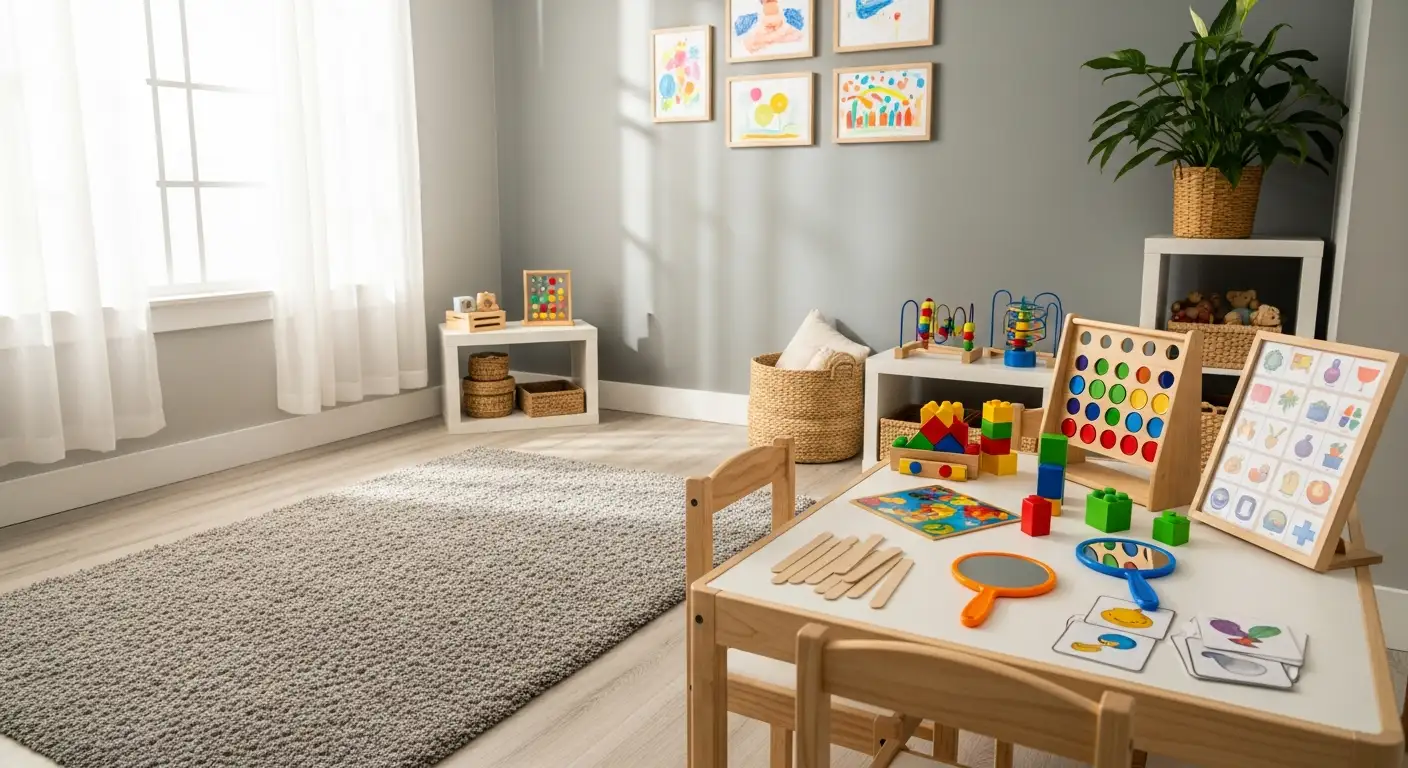A Comprehensive Guide to Child Therapy Options
Child therapy encompasses a variety of evidence-based approaches designed to support the emotional, behavioral, and developmental needs of young individuals. Understanding the different types of therapy available helps parents, caregivers, and practitioners select the most suitable interventions to promote resilience, improve social skills, and foster healthy emotional development throughout childhood and adolescence.
Main Types of Child Therapy
 There are several approaches used in child therapy to help young people manage emotional, behavioral, and developmental challenges. Each type of therapy is tailored to the child's age, specific needs, and the issues they face, often combining creative, talk, and activity-based methods.
There are several approaches used in child therapy to help young people manage emotional, behavioral, and developmental challenges. Each type of therapy is tailored to the child's age, specific needs, and the issues they face, often combining creative, talk, and activity-based methods.
What are the main types of therapy used for children?
One of the most common therapies is cognitive-behavioral therapy (CBT). This approach helps children recognize and change unhelpful thoughts and behaviors. It is especially effective for anxiety, depression, PTSD, OCD, and mood disorders. Using techniques like journaling, role-playing, and mindfulness exercises, CBT empowers children to develop healthier thinking patterns.
Play therapy is another popular method, particularly for younger children. It uses toys, games, and activities to allow children to express feelings they might find hard to verbalize. Through play, children process emotions, resolve conflicts, and learn problem-solving skills in a safe and supportive environment.
Family therapy seeks to improve communication and relationships within the family unit. It involves working with the child and family members to address family dynamics that impact the child's mental health. This approach can help resolve conflicts, support behavior change, and strengthen familial bonds.
Animal-assisted therapy incorporates trained animals such as dogs or horses to reduce stress and facilitate emotional expression. It’s particularly effective in hospital or trauma settings, helping children feel more comfortable and engaged in therapy.
Dialectical behavior therapy (DBT) is an adaptation of CBT focused on emotional regulation, distress tolerance, and interpersonal effectiveness. It is often used with teens experiencing intense emotions, self-harm, or suicidal thoughts. DBT combines mindfulness practices with behavioral strategies to help children navigate emotional difficulties.
Trauma-focused CBT (TF-CBT) is specifically designed to help children cope with traumatic events like abuse, accidents, or loss. This therapy helps children process traumatic memories safely and develop resilience, reducing symptoms of post-traumatic stress.
Exposure response prevention (ERP) is used mainly for obsessive-compulsive disorder (OCD) and phobias. It involves gradual exposure to fears or triggers while teaching children ways to tolerate anxiety without performing compulsive behaviors, reducing avoidance and compulsions over time.
Eye movement desensitization and reprocessing (EMDR) is applied to children who have experienced trauma. It involves guided eye movements while processing distressing memories, helping to diminish their emotional impact.
Psychodynamic therapy explores unconscious patterns, past experiences, and emotional conflicts. It can be helpful for longstanding issues such as depression, anxiety, and relational difficulties, allowing children to gain insight into underlying causes of their symptoms.
Occupational therapy (OT) supports children with sensory processing difficulties, motor skill delays, or developmental disabilities. OT focuses on improving everyday functioning, such as handwriting, self-care skills, and sensory regulation.
| Therapy Type | Focus Area | Ideal For | Techniques Used | Duration Usually Varies |
|---|---|---|---|---|
| Cognitive-Behavioral Therapy (CBT) | Thought and behavior change | Anxiety, depression, OCD | Journaling, role-play, mindfulness | Short-term (8-20 sessions) |
| Play therapy | Emotional expression | Young children, trauma | Play activities, art | Varies based on needs |
| Family therapy | Family dynamics | Behavioral issues, conflicts | Family sessions, communication exercises | Ongoing or short-term |
| Animal-assisted therapy | Emotional support | Anxiety, trauma | Interaction with animals | Varies |
| Dialectical Behavior Therapy (DBT) | Emotional regulation | Self-harm, suicidal teens | Mindfulness, skills training | Long-term, usually 6-12 months |
| Trauma-focused CBT | Trauma processing | Trauma survivors, abuse | Narrative building, coping skills | Around 12-16 sessions |
| Exposure Response Prevention (ERP) | Fear reduction | OCD, phobias | Gradual exposure | Varies by individual |
| EMDR | Trauma processing | PTSD, trauma | Bilateral stimulation | Typically 6-12 sessions |
| Psychodynamic therapy | Unconscious patterns | Longstanding emotional issues | Talking, exploring past experiences | Long-term |
| Occupational therapy (OT) | Developmental skills | Sensory processing, motor delays | Activities, sensory integration | Ongoing, based on goals |
Understanding which therapy suits a child depends heavily on their unique circumstances. Healthcare professionals evaluate the child's symptoms, age, developmental stage, and family context to recommend the most appropriate approach. Often, therapists may combine multiple methods to create a comprehensive treatment plan.
In conclusion, these therapy options are designed to foster resilience, improve social and emotional skills, and support mental health. Their collaborative nature, involving children, families, and sometimes schools or caregivers, helps build a supportive environment for sustained growth and healing.
Conditions Addressed by Child Therapy

What conditions or issues can child therapy address?
Child therapy offers supportive interventions for a broad spectrum of emotional, behavioral, and mental health challenges. It is particularly effective in helping children cope with and understand issues such as anxiety, depression, trauma, and post-traumatic stress disorder (PTSD). These conditions can manifest through symptoms like withdrawal, mood swings, aggression, or social withdrawal, often stemming from stressful life events, grief, or developmental concerns.
In addition to mood disorders, child therapy also tackles behavioral problems such as oppositional behavior, hyperactivity, and difficulties with social interactions. For children experiencing autism spectrum disorder (ASD), therapy helps develop communication, social skills, and manage sensory sensitivities. Attention-deficit/hyperactivity disorder (ADHD) and learning difficulties are also addressed, with interventions aimed at improving focus, organization, and behavioral regulation.
Children facing eating disorders, sleep disturbances, or difficulties adapting to new environments, such as starting school or experiencing family changes, benefit from tailored therapeutic approaches. Therapy methods, including play therapy, art therapy, cognitive-behavioral therapy (CBT), and family therapy, facilitate emotional expression, teach coping skills, and foster resilience.
These therapeutic interventions not only aim to reduce symptoms but also promote emotional regulation, boost self-confidence, and improve communication skills. Ultimately, child therapy plays a crucial role in helping young individuals develop healthier emotional responses and social interactions, supporting their overall growth and well-being.
| Issue / Condition | Typical Symptoms | Suitable Therapy Approaches | Additional Notes |
|---|---|---|---|
| Anxiety & depression | Mood swings, withdrawal, worries | CBT, Play Therapy, Art Therapy | Helps develop coping strategies and emotional awareness |
| Trauma & PTSD | Flashbacks, emotional numbness, hypervigilance | Trauma-Focused CBT, EMDR | Focuses on processing traumatic memories |
| Behavioral problems | Oppositional acts, tantrums, aggression | Behavior Therapy, PCIT | Reinforces positive behaviors at home and school |
| Autism Spectrum Disorder | Communication delays, sensory issues | ABA, Social Skills Training | Promotes skill development and reduces problematic behaviors |
| ADHD & learning struggles | Inattention, hyperactivity, organizational issues | Organizational Skills Training, Behavioral Therapy | Strategies for improved focus and routines |
| Eating & sleep disorders | Poor appetite, bedwetting, sleep disturbances | Family Therapy, CBT, OT | Addresses nutritional health and routines |
| Family conflicts & relational issues | Communication breakdown, frequent disagreements | Family Therapy, Parent-child Interaction Therapy | Enhances understanding and cooperation |
| Effects of abuse or neglect | Trauma reactions, trust issues | TF-CBT, Play Therapy | Safe environment for expression and healing |
| Adjustment to developmental transitions | Anxiety about school, new sibling | Supportive Play, Art Therapy, Psychodynamic Therapy | Eases anxieties related to change |
This overview highlights how versatile child therapy can be in tackling various psychological and behavioral issues, emphasizing its role in fostering healthy development and emotional resilience.
Therapeutic Approaches and Techniques Tailored for Children
What are the different therapeutic approaches and techniques used for children?
Children's therapy employs a diverse array of approaches, each tailored to developmental stages and individual needs. These methods aim to support emotional well-being, address behavioral challenges, and promote resilience.
One of the most common therapies is Cognitive-Behavioral Therapy (CBT). It helps children identify and modify distorted thinking patterns that can lead to negative emotions or behaviors. In children, CBT is often adapted with simplified language, visual aids, and activities like worksheets and role-playing, making it engaging and accessible.
Play therapy is another widely used approach, especially for younger children. It leverages play as a natural medium for expression. Through toys, games, and imaginative activities, children can communicate feelings they may not be able to articulate verbally. Play therapy can be child-centered, where the therapist follows the child's lead, or incorporate specific interventions based on cognitive-behavioral principles.
Family therapy involves multiple family members working together to improve communication and relationships. It is particularly useful when family dynamics contribute to the child's difficulties. Techniques include real-time coaching of parents through Parent-Child Interaction Therapy (PCIT), which coaches parents on reinforcing positive behaviors and managing problematic ones during interactions.
Expressive arts therapies, such as art, music, dance, and drama therapy, allow children to process emotions creatively. These approaches are especially beneficial for children who find it difficult to express their feelings through words.
For children facing specific issues, techniques like exposure therapy, including Exposure and Response Prevention (ERP), are used to help confront fears gradually. Systematic desensitization often combines relaxation training with exposure to feared stimuli.
Trauma-focused CBT (TF-CBT) is designed to help children recover from traumatic events, using structured activities to process memories and reduce post-traumatic stress.
Psychodynamic therapy explores unconscious patterns often rooted in past experiences or conflicts, helping children understand the origins of their behaviors.
Behavior modification and reinforcement strategies focus on modifying environmental responses to encourage desirable behaviors and reduce undesirable ones. This often involves reward systems and routine-setting at home and school.
Mindfulness and acceptance activities teach children to observe their thoughts and feelings without judgment, fostering emotional regulation. Techniques include breathing exercises, guided imagery, and accepting difficult emotions.
Parent training and interaction coaching, such as PCIT, equips parents with skills to manage behaviors effectively, strengthen bonds, and support emotional development.
Occupational therapy (OT) plays a crucial role for children with sensory sensitivities, developmental delays, or learning disabilities, focusing on improving motor skills, cognitive function, and adaptive behaviors.
How do these approaches come together?
Most effective treatment plans combine multiple techniques. For example, a child with anxiety may undergo CBT modules, combined with exposure therapies and mindfulness activities. Simultaneously, parents might receive training to reinforce skills at home.
Therapists tailor each plan based on ongoing assessments, integrating approaches that resonate with the child's age, culture, and particular challenges. This multisystem method ensures an environment that is both supportive and effective in fostering healing and development.
Through these diverse therapies, children gain valuable tools for managing emotions, improving social skills, and navigating life's challenges with resilience and confidence.
| Approach/Technique | Age Group Focus | Main Goals | Common Activities | Suitable For |
|---|---|---|---|---|
| Cognitive-Behavioral Therapy (CBT) | 8+ years | Change negative thoughts | Worksheets, role-play | Anxiety, depression, OCD |
| Play Therapy | Preschool & school-age | Emotional expression | Toys, storytelling | Trauma, emotional challenges |
| Family Therapy | All ages | Improve family dynamics | Family sessions, communication exercises | Behavioral, emotional issues |
| Expressive Arts Therapies | All ages | Emotional processing | Art, music, dance | Trauma, self-esteem, depression |
| Exposure Therapy (ERP & Systematic Desensitization) | 6+ years | Reduce fears | Gradual exposure | Phobias, OCD |
| Trauma-Focused CBT | 7+ years | Recover from trauma | Structured activities | Abuse, trauma |
| Psychodynamic Therapy | Older children & adolescents | Unconscious patterns | Talk therapy | Deep-rooted emotional issues |
| Behavior Modification | All ages | Reinforce positive behaviors | Rewards, routines | ADHD, oppositional behaviors |
| Mindfulness & Acceptance | All ages | Emotional regulation | Breathing, visualization | Anxiety, emotional dysregulation |
| Parent Training (PCIT) | 2–12 years | Strengthen parent-child bonds | Parent coaching | Behavioral problems |
| Occupational Therapy | 3+ years | Enhance motor & cognitive skills | Sensory activities | Developmental delays, sensory issues |
Effective therapy for children is holistic and adaptable. It recognizes that emotional and behavioral development takes time and patience, and it often involves the child's family and environment. The goal is to foster resilience, teach coping skills, and support healthy growth.
When Children Might Need Therapy
What are signs that children may require therapy?
Children's emotional and behavioral health can sometimes show signs that professional support is needed. Recognizing these signs early can be crucial for effective intervention and supporting the child's well-being.
Persistent mood or behavioral changes
One of the most obvious indicators is when a child experiences ongoing changes in mood or behavior. This may include prolonged sadness, irritability, anger, or mood swings that last more than two weeks. Such shifts can be signals of depression, anxiety, or other emotional difficulties that may benefit from therapeutic intervention.
Withdrawal or social isolation
Children who suddenly withdraw from friends, family, and social activities may be trying to cope with underlying emotional struggles. Avoidance of social interactions can be linked to anxiety, depression, or trauma. If these patterns persist, therapy can help the child express their feelings and rebuild social confidence.
School or family difficulties
Difficulties at school, such as declining grades, trouble concentrating, or disruptive behavior, can be related to emotional distress. Similarly, challenges within the family—like conflicts, poor communication, or significant life changes—can affect a child's mental health.
Additional signs prompting therapy consideration
- Self-harm behaviors or expressions of suicidal thoughts.
- Physical symptoms such as frequent headaches or stomach aches without medical causes.
- Significant changes in sleep patterns or appetite.
- Problems with self-esteem, identity, or developing healthy relationships.
When to seek professional help
If these signs interfere with a child's daily life—such as their ability to enjoy activities, maintain friendships, perform at school, or engage with family—therapy may be a valuable resource.
Therapy options range from play therapy, which is effective for younger children, to Cognitive Behavioral Therapy (CBT) and Dialectical Behavior Therapy (DBT) for adolescents. These approaches aim to help children understand their feelings, develop healthy coping strategies, and improve overall functioning.
The importance of early intervention
Addressing issues early, before they escalate, can prevent more serious mental health conditions and promote resilience. Families should consider seeking professional advice if they notice persistent or worsening challenges.
By providing a supportive environment and appropriate therapy, children can learn to navigate their emotions healthily and develop skills that serve them throughout life.
Benefits and Goals of Child Therapy

What are the benefits and purposes of child therapy?
Child therapy provides a wide range of benefits that are vital for the healthy emotional and psychological development of young individuals. Its primary goal is to equip children with tools to manage their feelings, behaviors, and relationships effectively.
One of the main benefits of child therapy is enhancing emotional regulation and self-awareness. Children learn to identify, understand, and express their feelings in safe and constructive ways. Techniques like play therapy and cognitive-behavioral therapy (CBT) help children recognize unhelpful thought patterns and replace them with healthier ones.
Building resilience and social skills is also a core purpose. Therapy facilitates skill development that enables children to cope with stress, adapt to change, and handle social interactions more confidently. This is especially important during childhood and adolescence when social dynamics and emotional challenges are prominent.
Supporting academic and personal growth is another critical goal. When children address issues like anxiety, depression, or behavioral problems, they often see improvements in concentration, motivation, and academic performance. Therapy fosters a positive self-image and self-esteem, promoting lifelong mental health.
Processing trauma and loss constitutes a significant part of child therapy, especially for those who have experienced major life changes, abuse, or bereavement. Trauma-focused cognitive-behavioral therapy (TF-CBT) helps children work through difficult memories and feelings, reducing long-term psychological impact.
Improving family relationships is essential for ongoing emotional well-being. Family-based therapies and parent-involved approaches like Parent-Child Interaction Therapy (PCIT) strengthen communication, reduce conflicts, and nurture supportive environments at home.
Overall, child therapy aims to promote emotional resilience, healthier relationships, and personal growth. It supports children in managing present challenges and prepares them for future success and well-being.
| Benefit/Goal | Description | Therapy Methods Included |
|---|---|---|
| Emotional regulation | Helping children understand and control their emotions | CBT, play therapy, DBT |
| Self-awareness | Increasing understanding of personal feelings and behaviors | Psychodynamic therapy, humanistic approaches |
| Resilience and social skills | Building capacity to handle stress, adapt, and foster healthy relationships | Social Skills Training, Group therapy |
| Academic and personal growth | Improving concentration, motivation, and confidence | Educational support strategies |
| Trauma processing | Assisting children in coping with traumatic experiences | TF-CBT, EMDR |
| Family relationship improvement | Enhancing communication and emotional bonds within families | Family therapy, PCIT |
This comprehensive approach ensures children develop not only specific skills but also a resilient mindset that supports their overall growth and mental health, establishing a foundation for lifelong well-being.
Guidance for Parents and Practitioners in Choosing Therapy

How do I choose the right type of therapy for a child?
Choosing the appropriate therapy for a child requires a thoughtful process that begins with a thorough assessment conducted by a qualified mental health professional. This evaluation includes observing the child's behaviors, understanding their developmental stage, considering family dynamics, and identifying specific concerns such as anxiety, depression, behavioral challenges, trauma, or developmental delays.
Evidence-based treatment options are often tailored to meet these individual needs. For young children or those who have experienced trauma, interventions like Play Therapy or Trauma-Focused Cognitive Behavioral Therapy (TF-CBT) are particularly suitable. These therapies utilize creative and expressive methods to facilitate emotional processing and resilience without relying heavily on verbal communication.
For older children and teenagers, more structured approaches like Cognitive Behavioral Therapy (CBT), Dialectical Behavior Therapy (DBT), or Interpersonal Psychotherapy (IPT) have shown strong effectiveness. CBT helps children recognize and modify negative thought patterns and behaviors, while DBT focuses on emotional regulation, especially in high-risk cases such as self-harm or suicidal ideation.
Collaborative planning involving the child's family is essential. Parents, caregivers, and the child should work together with mental health professionals to develop a personalized treatment plan. This plan should include clear goals, regular progress reviews, and flexibility to adjust the therapy methods as the child’s needs evolve.
Understanding the child's developmental stage aids in selecting age-appropriate techniques. For instance, visual arts, play, and storytelling are useful for younger children, while more verbal and cognitive strategies are suited for adolescents.
Maintaining open communication and establishing trust are vital components throughout the treatment journey. Consistent updates and shared decision-making help ensure the therapy remains aligned with the child's progress and family circumstances.
In summary, choosing the right therapy involves a comprehensive evaluation, considering evidence-based approaches tailored to developmental needs, and fostering a collaborative relationship between families and mental health providers. This approach maximizes the potential for positive outcomes and supports the child's emotional and behavioral growth.
More information:
Search query: how to choose child therapy
This guidance aims to empower parents and practitioners with the knowledge needed to make informed decisions about therapeutic interventions, ultimately fostering resilience and well-being in children.
Characteristics and Applications of Child Therapy
What are the characteristics and applications of child therapy?
Child therapy is a specialized form of mental health treatment designed specifically for children and adolescents. It focuses on addressing emotional, behavioral, developmental, and trauma-related issues that can impact a young person's growth and well-being.
One of the most defining features of child therapy is its use of age-appropriate and engaging techniques. Techniques like play therapy, art therapy, storytelling, role-playing, and cognitive-behavioral methods are tailored to resonate with children’s developmental stages. These approaches allow children to express feelings and thoughts they might not yet have the words for, fostering emotional understanding and self-awareness.
Therapists trained in child therapy adopt various methods depending on the child's needs, including psychodynamic therapy to explore unconscious patterns, behavioral therapy to modify problematic behaviors, or trauma-focused therapies to help process difficult experiences. The goal is to create a safe, supportive environment where children feel comfortable exploring their emotions.
Applications of child therapy are wide-ranging. It is effectively used to treat anxiety, depression, post-traumatic stress disorder (PTSD), and behavioral problems such as oppositional defiant disorder and ADHD. Additionally, therapy can help children with autism spectrum disorder adjust socially and develop communication skills.
Family involvement often enhances therapy outcomes. Family therapy or parent-child interaction therapy (PCIT) can improve communication, strengthen relationships, and address family dynamics impacting the child's mental health.
Child therapy also plays a vital role in supporting development during key transitional phases, such as divorce or loss of a loved one, or after traumatic events like abuse or witnessing violence. It aims to foster resilience, emotional regulation, and social skills necessary for healthier interactions.
In summary, child therapy is characterized by its tailored, engaging approaches that meet children where they are developmentally. Its applications span a broad spectrum of emotional, behavioral, and developmental challenges, providing young individuals with the tools and support needed to lead healthier, more balanced lives.
Empowering Children Through Effective Therapy Options
Understanding the diverse range of therapies available for children enables caregivers and professionals to select the most appropriate, evidence-based interventions tailored to each child's unique needs. Early and targeted therapeutic support can significantly improve emotional regulation, social competence, and resilience, laying a strong foundation for healthy development and well-being. As research advances, integrating innovative approaches with traditional therapies promises to enhance outcomes and foster a brighter future for children facing emotional, behavioral, and developmental challenges.
References
- What kind of therapy is right for my child? - Mayo Clinic Press
- Therapy for kids: Types, techniques, where to find it
- Different Types of Therapy for Kids and Their Benefits
- What Are the Different Types of Child Therapy? - Katie Lear
- Finding the Right Child Therapist and Therapy
- 14 types of therapy for kids and the benefits of each - Care.com
- An Overview of Play Therapy - PMC - PubMed Central
- What are the different types of children's counselling? - Mable Therapy
- Treating Children's Mental Health with Therapy - CDC
- Behavioral Treatments at a Glance - Child Mind Institute






